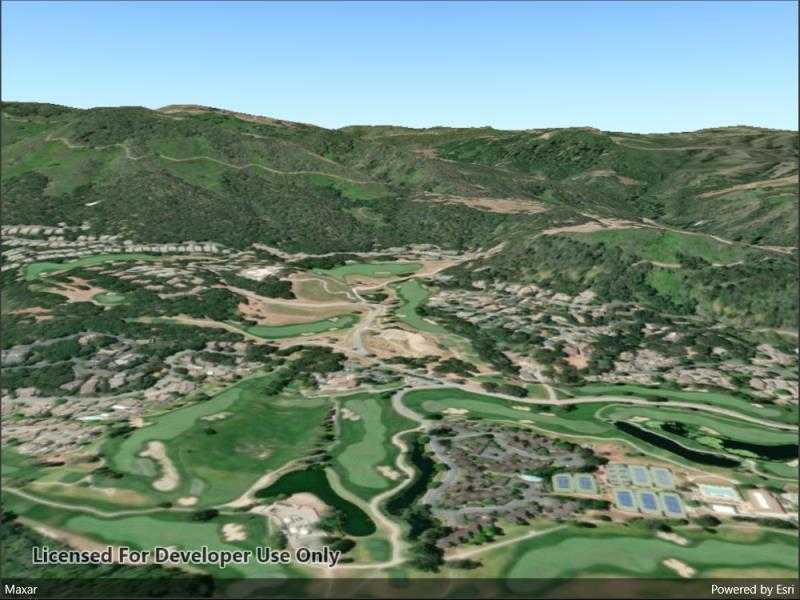Set the terrain surface with elevation described by a local tile package.

Use case
In a scene view, the terrain surface is what the basemap, operational layers, and graphics are draped onto. For example, when viewing a scene in a mountainous region, applying a terrain surface to the scene will help in recognizing the slopes, valleys, and elevated areas.
How to use the sample
When loaded, the sample will show a scene with a terrain surface applied. Pan and zoom to explore the scene and observe how the terrain surface allows visualizing elevation differences.
How it works
- Create a
Sceneand add it to aSceneView. - Create an
ArcGISTiledElevationSourcewith the path to the local tile package. - Add this source to the scene's base surface:
Scene.BaseSurface.ElevationSources.Add(tiledElevationSource).
Relevant API
- ArcGISTiledElevationSource
- Surface
About the data
This sample uses the Monterey Elevation tile package, using CompactV2 storage format (.tpkx).
Additional information
The tile package must be a LERC (limited error raster compression) encoded TPK/TPKX. Details can be found in the topic Share a tile package in the ArcGIS Pro documentation.
Tags
3D, elevation, LERC, surface, terrain, tile cache
Sample Code
// Copyright 2022 Esri.
//
// Licensed under the Apache License, Version 2.0 (the "License"); you may not use this file except in compliance with the License.
// You may obtain a copy of the License at: http://www.apache.org/licenses/LICENSE-2.0
//
// Unless required by applicable law or agreed to in writing, software distributed under the License is distributed on an
// "AS IS" BASIS, WITHOUT WARRANTIES OR CONDITIONS OF ANY KIND, either express or implied. See the License for the specific
// language governing permissions and limitations under the License.
using ArcGIS.Samples.Managers;
using Esri.ArcGISRuntime.Mapping;
namespace ArcGIS.Samples.CreateTerrainSurfaceTilePackage
{
[ArcGIS.Samples.Shared.Attributes.Sample(
name: "Create terrain from local tile package",
category: "Scene",
description: "Set the terrain surface with elevation described by a local tile package.",
instructions: "When loaded, the sample will show a scene with a terrain surface applied. Pan and zoom to explore the scene and observe how the terrain surface allows visualizing elevation differences.",
tags: new[] { "3D", "LERC", "elevation", "surface", "terrain", "tile cache" })]
[ArcGIS.Samples.Shared.Attributes.OfflineData("52ca74b4ba8042b78b3c653696f34a9c")]
public partial class CreateTerrainSurfaceTilePackage : ContentPage
{
public CreateTerrainSurfaceTilePackage()
{
InitializeComponent();
Initialize();
}
private void Initialize()
{
// Create the scene.
MySceneView.Scene = new Scene(BasemapStyle.ArcGISImageryStandard);
// Get the path to the elevation tile package.
string packagePath = DataManager.GetDataFolder("52ca74b4ba8042b78b3c653696f34a9c", "MontereyElevation.tpkx");
// Create the elevation source from the tile cache.
TileCache elevationCache = new TileCache(packagePath);
ArcGISTiledElevationSource elevationSource = new ArcGISTiledElevationSource(elevationCache);
// Create a surface to display the elevation source.
Surface elevationSurface = new Surface();
// Add the elevation source to the surface.
elevationSurface.ElevationSources.Add(elevationSource);
// Add the surface to the scene.
MySceneView.Scene.BaseSurface = elevationSurface;
// Set an initial camera viewpoint.
Camera camera = new Camera(36.525, -121.80, 300.0, 180, 80.0, 0.0);
MySceneView.SetViewpointCamera(camera);
}
}
}